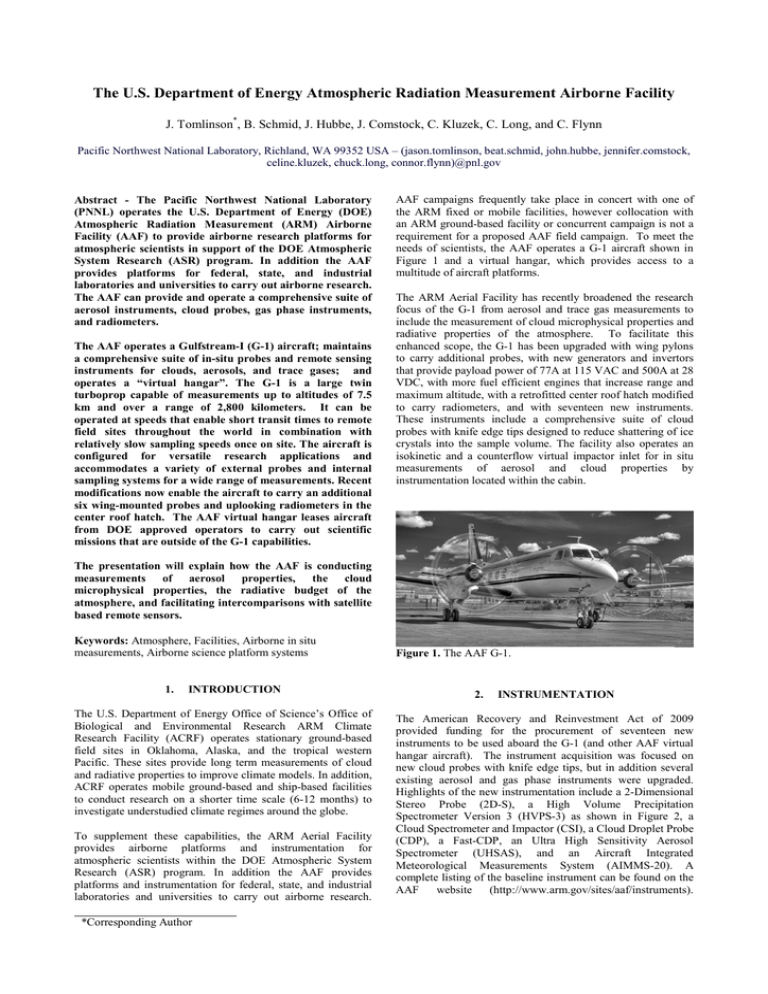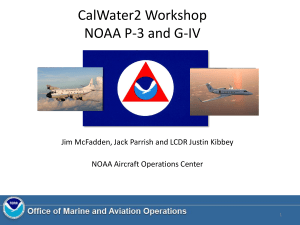The U.S. Department of Energy Atmospheric Radiation Measurement Airborne Facility
advertisement

The U.S. Department of Energy Atmospheric Radiation Measurement Airborne Facility J. Tomlinson*, B. Schmid, J. Hubbe, J. Comstock, C. Kluzek, C. Long, and C. Flynn Pacific Northwest National Laboratory, Richland, WA 99352 USA – (jason.tomlinson, beat.schmid, john.hubbe, jennifer.comstock, celine.kluzek, chuck.long, connor.flynn)@pnl.gov Abstract - The Pacific Northwest National Laboratory (PNNL) operates the U.S. Department of Energy (DOE) Atmospheric Radiation Measurement (ARM) Airborne Facility (AAF) to provide airborne research platforms for atmospheric scientists in support of the DOE Atmospheric System Research (ASR) program. In addition the AAF provides platforms for federal, state, and industrial laboratories and universities to carry out airborne research. The AAF can provide and operate a comprehensive suite of aerosol instruments, cloud probes, gas phase instruments, and radiometers. The AAF operates a Gulfstream-I (G-1) aircraft; maintains a comprehensive suite of in-situ probes and remote sensing instruments for clouds, aerosols, and trace gases; and operates a “virtual hangar”. The G-1 is a large twin turboprop capable of measurements up to altitudes of 7.5 km and over a range of 2,800 kilometers. It can be operated at speeds that enable short transit times to remote field sites throughout the world in combination with relatively slow sampling speeds once on site. The aircraft is configured for versatile research applications and accommodates a variety of external probes and internal sampling systems for a wide range of measurements. Recent modifications now enable the aircraft to carry an additional six wing-mounted probes and uplooking radiometers in the center roof hatch. The AAF virtual hangar leases aircraft from DOE approved operators to carry out scientific missions that are outside of the G-1 capabilities. AAF campaigns frequently take place in concert with one of the ARM fixed or mobile facilities, however collocation with an ARM ground-based facility or concurrent campaign is not a requirement for a proposed AAF field campaign. To meet the needs of scientists, the AAF operates a G-1 aircraft shown in Figure 1 and a virtual hangar, which provides access to a multitude of aircraft platforms. The ARM Aerial Facility has recently broadened the research focus of the G-1 from aerosol and trace gas measurements to include the measurement of cloud microphysical properties and radiative properties of the atmosphere. To facilitate this enhanced scope, the G-1 has been upgraded with wing pylons to carry additional probes, with new generators and invertors that provide payload power of 77A at 115 VAC and 500A at 28 VDC, with more fuel efficient engines that increase range and maximum altitude, with a retrofitted center roof hatch modified to carry radiometers, and with seventeen new instruments. These instruments include a comprehensive suite of cloud probes with knife edge tips designed to reduce shattering of ice crystals into the sample volume. The facility also operates an isokinetic and a counterflow virtual impactor inlet for in situ measurements of aerosol and cloud properties by instrumentation located within the cabin. The presentation will explain how the AAF is conducting measurements of aerosol properties, the cloud microphysical properties, the radiative budget of the atmosphere, and facilitating intercomparisons with satellite based remote sensors. Keywords: Atmosphere, Facilities, Airborne in situ measurements, Airborne science platform systems 1. INTRODUCTION The U.S. Department of Energy Office of Science’s Office of Biological and Environmental Research ARM Climate Research Facility (ACRF) operates stationary ground-based field sites in Oklahoma, Alaska, and the tropical western Pacific. These sites provide long term measurements of cloud and radiative properties to improve climate models. In addition, ACRF operates mobile ground-based and ship-based facilities to conduct research on a shorter time scale (6-12 months) to investigate understudied climate regimes around the globe. To supplement these capabilities, the ARM Aerial Facility provides airborne platforms and instrumentation for atmospheric scientists within the DOE Atmospheric System Research (ASR) program. In addition the AAF provides platforms and instrumentation for federal, state, and industrial laboratories and universities to carry out airborne research. *Corresponding Author Figure 1. The AAF G-1. 2. INSTRUMENTATION The American Recovery and Reinvestment Act of 2009 provided funding for the procurement of seventeen new instruments to be used aboard the G-1 (and other AAF virtual hangar aircraft). The instrument acquisition was focused on new cloud probes with knife edge tips, but in addition several existing aerosol and gas phase instruments were upgraded. Highlights of the new instrumentation include a 2-Dimensional Stereo Probe (2D-S), a High Volume Precipitation Spectrometer Version 3 (HVPS-3) as shown in Figure 2, a Cloud Spectrometer and Impactor (CSI), a Cloud Droplet Probe (CDP), a Fast-CDP, an Ultra High Sensitivity Aerosol Spectrometer (UHSAS), and an Aircraft Integrated Meteorological Measurements System (AIMMS-20). A complete listing of the baseline instrument can be found on the AAF website (http://www.arm.gov/sites/aaf/instruments). Funding was also included for the modernization of the aircraft data system and installation of an onboard gigabit network. This provides instant access to onboard instrumentation and allows scientists to remain safely seated while monitoring data collected during flights. The addition of this instrumentation will enable the G-1 to participate in a broader range of field campaigns designed to calibrate and validate remote sensing instrumentation and techniques. All data collected during the AAF field campaigns are freely available from the ARM archives. In addition, the data are compiled into a merged data file for easier use. The AAF website (http://www.arm.gov/sites/aaf) contains detailed information about each field campaign and includes a link to the archives. 4. Figure 2. A 2D-S, HVPS-3, and Cloud Aerosol Precipitation Spectrometer (CAPS) cloud probe with knife edge tips mounted to the wing pylon on the G-1 3. RECENT FIELD CAMPAIGNS AND DATA AVAILABILITY The AAF has extensive experience leasing a broad range aircraft from other agencies through the virtual hangar. The facility has worked with 13 different aircraft from NASA, NOAA, the National Research Council of Canada, Office of Naval Research, Dukes University, Sky Research, Greenwood Aviation and Stratton Park Engineering Company (SPEC), Inc. The AAF has recently conducted two extended field campaigns out of the virtual hangar. These campaigns were conducted over 6 month periods in an effort to obtain a more statistically significant data set. The Routine AAF Clouds with Low Optical Water Depths (CLOWD) Optical Radiative Observations (RACORO) field campaign was conducted from January to the end of June in 2009 to study CLOWD type clouds over the ACRF field site in Oklahoma. The data collected will help scientist better retrieve properties of CLOWD type of clouds using remote sensing techniques. From January to the end of June 2010, the AAF conducted the Small Particles in Cirrus (SPARTICUS) field campaign. This campaign was focused on the measurement of cirrus clouds over the ACRF field site in Oklahoma and in coordination with the A-Train satellite overpasses. These measurements have built a database of cirrus cloud properties over the central United States. The AAF recently conducted the Carbonaceous Aerosols and Radiative Effects Study (CARES) utilizing the G-1 aircraft. The study carried out in June of 2010 was designed to increase the scientific knowledge of the evolution of black carbon and secondary organic aerosols from both anthropogenic and biogenic sources. The study was focused on the Sacramento area and the foothills of the Sierra Nevada Mountains to the Northeast. Flight operations were coordinated at times with aircraft operated by NOAA during the CALNEX project. AAF FUTURE UPGRADES With the modernization of the aerosol and gas phase instruments and the acquisition of new cloud probes complete, the AAF will be focusing on upgrading the available radiometer package aboard the G-1 in 2011. The primary solar radiometer will be a Sunshine Pyranometer (SPN-1), which measures total and diffuse shortwave irradiance with a 0.3 second 95% response time. Having the solar component measurements enables the correction of the broadband shortwave irradiance for aircraft tilting (Long et al., 2010), while the rapid response time combined with rapid sampling allows for better documentation of the rapidly changing radiation when flying into, out of, and through clouds. An unshaded version of the SPN-1 has been developed and will be used to measure the upward and downward total shortwave irradiance. In addition the aircraft will be outfitted with upward and downward facing longwave precision infrared radiometers (PIR), an upward and downward facing multi filter radiometer (MFR), with a 1625 nm channel added, for the measurement of surface spectral albedo, and a narrow field of view (NFOV) infrared thermometer (IRT) facing upward and downward. This modernized package will enable rapid and accurate measurements of the atmosphere’s and underlying surface radiative properties. The aircraft will be updated in 2011 with long-range fuel tanks. This addition along with the more fuel-efficient engines will push the maximum range of the aircraft out over 4000 km. The increase in range will enable longer research flights and increase the number of atmospheric profiles conducted during a research flight. 5. CONCLUSION Over the past two years, the DOE AAF has implemented a multitude of improvements to the G-1 aircraft to increase the range, maximum altitude, and power available to scientists. Wing pylons can now be installed to carry six probes in addition to the two probes mounted on the nose struts. The aircraft can also operate both an isokinetic and counterflow virtual impactor inlet simultaneously. The facility has also procured seventeen new aerosol, gas, and cloud instruments. These can be operated on the G-1, and other aircraft operated by AAF out of the virtual hangar. During 2011, the aircraft radiometer package will be upgraded and will have the capability of applying a tilt correction to the shortwave irradiance measurements. These upgrades have transformed the G-1 aircraft to a global research platform and have given the AFF the in-situ and remote sensing capabilities of measuring a comprehensive set of properties of the atmosphere including thermodynamic, radiative, gas phase, aerosol, and cloud properties. More information about the AAF including the proposal process can be found on the AAF website. (http://www.arm.gov/sites/aaf). REFERENCES C.N. Long, A. Bucholtz, H. Jonsson, B. Schmid, A. Vogelmann and J. Wood, “A Method of Correcting for Tilt from Horizontal in Downwelling Shortwave Irradiance Measurements on Moving Platforms,” The Open Atmospheric Science Journal, vol 4, p.p. 78-87, 2010. ACKNOWLEDGEMENTS The AAF would like to thank its pilots and mechanics Bob Hannigan, Mike Hubbell, Dick Hone, Bill Svancara, and Gene Dukes for their continued hard work and dedication to safety.


